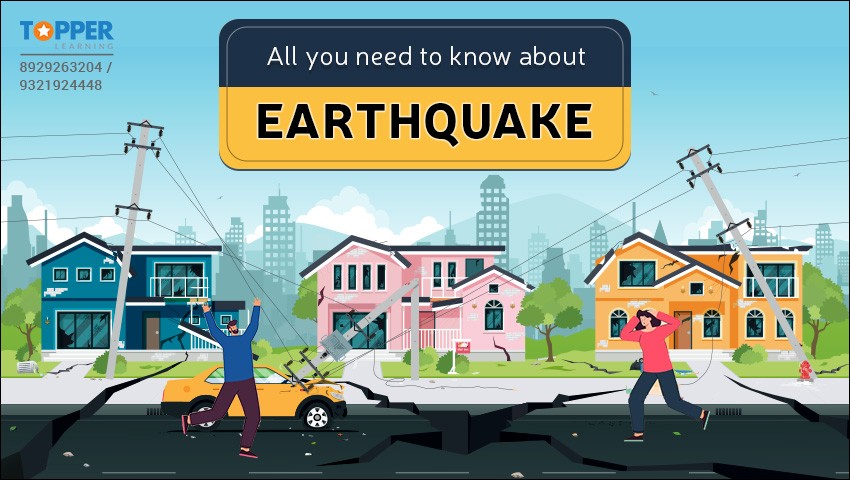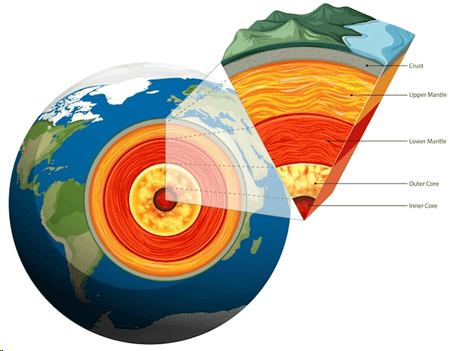All you need to know about Earthquake

Earthquakes are natural phenomena caused by the movement of tectonic plates. They originate under the ground and are felt as tremors on the surface. Learn the geography, new scale of magnitude measurement, and other aspects of earthquakes right here.
By Topperlearning Expert 27th Dec, 2023 | 12:41 pm
ShareHave you felt sudden shaking or movement while lying on the bed or sitting on a chair? Did your pets become vocal all of a sudden? Most of us have either felt an earthquake or heard of one.
Having affected masses and been the cause of massive-scale destruction, the earthquakes are sometimes mild while deadly at other times. Explore different basic aspects of an earthquake to understand it better. Also, learn about the recent one that caused around 127 casualties and damage to property!
Geography of Earthquake
 Though earthquakes
Though earthquakes
The Earth has four major layers: outer and inner core, mantle, and crust. The Earth is seen to exist in multiple pieces collected together to form a landmass. These pieces are called tectonic plates. They vary in size and remain in slow motion, where they slide against each other or, at times, bump into each other. The edges of tectonic plates are called plate boundaries, which are rough in texture. The roughness, referred to as faults, leads to tectonic plates getting stuck with respect to each other during movements. The stuck plates initially remain intact while the rest of the plate keeps moving. A situation arises when these plates ‘unstick’ at the faults. Then, the tremors are felt, referred to as earthquakes.
Reason for Tremors During Earthquake
The movement requires energy. So, the moving part of the tectonic plate consumes its share of energy, but the stuck part has energy build-up. The force of moving parts eventually unsticks the faults, overcoming the holding force. This situation marks the release of energy felt as seismic waves. You can visualise the spread of seismic waves as the ripples in the pond are seen on throwing a pebble.
These seismic waves are strong enough to shake the Earth and are felt as tremors. The intensity of the release of energy and, hence, these seismic waves are responsible for the intensity of earthquakes.
Terms of Earthquake
The important terms that should be familiar when talking about earthquakes are:
Fault plane: The planar surface of tectonic plates comprising fractures and is the site of relative displacement of blocks.
Foreshocks: Smaller seismic events before the earthquake.
Mainshocks: It is the largest earthquake event in seismic sequence.
Aftershocks: Small seismic events following the mainshock.
Hypocenter: The actual location beneath the Earth’s surface where an earthquake originates.
Epicentre: The point on the Earth’s surface located directly above the hypocentre.
Magnitude: Measure of the energy released or strength of an earthquake.
Recording Earthquake
The earthquake is recorded using the seismograph. It is the instrument with the base stuck firmly to the ground and an attached heavyweight hanging through a spring. The hanging weight remains unshaken during the earthquake while the base moves with the ground waves. The pattern of movement through the contact between the end of the heavyweight and the base is used to identify the intensity of an earthquake. This recording is referred to as a seismogram.
Measuring Earthquake
The earthquake can be measured either through magnitude or through intensity. The intensity refers to the shaking of the ground that leads to damage. The magnitude can be measured through the Richter scale. The seismogram obtained from the seismograph provides a scribble of lines with different amplitudes. The larger amplitude signifies a stronger earthquake. Richter scale is logarithmic in nature and assigns a single number to the earthquake, referred to as its magnitude. The logarithmic nature describes the ten-fold increase in amplitude for each difference. For instance, magnitude 5 indicates 10 times larger amplitude and about 31.6 times more energy release compared to a magnitude 4 earthquake.
Recent Major Earthquakes
Though earthquakes are not uncommon, the variation in intensity distinguishes their effect and recognition by residents of any area. Considering Dec 21, 2023, alone, the planet Earth witnessed a total of around 41 earthquakes ranging from magnitude 2.5 to 6.1. However, the recent earthquake, which made the news due to a large number of casualties, was witnessed in China, Japan and Turkey.
Earthquake at China
On Dec 19, 2023, the tremors of 5.9 magnitude hit northwest China, causing significant damage. The houses collapsed, and people ran for safety on the streets at Gansu, near the Qinghai border. Further, the Chinese President also called for ‘all-out efforts’ in search and relief work. The epicentre of the earthquake was located around 100 kilometres southwest of Gansu province’s capital, Lanzhou. The incident also witnessed several smaller aftershocks. The bone-chilling temperatures dropped to -14 degrees Celsius before 1 P.M. added to the issues in carrying out rescue services.
Earthquake at Turkey
Turkey witnessed a 4.5 magnitude earthquake on Dec 28, 2023. The hypocentre was 10 kilometres below the Earth's surface, according to the German Centre for Geosciences. Concerning the epicentre, it was located at 17 km SSE of Akcadag, Turkey.
Earthquake at Japan
On New Year's Day, i.e., Monday, Jan 1, 2024, Japan witnessed a terrible earthquake with a high magnitude of 7.5. With the tremors felt in central Ishikawa prefecture, the aftershocks were multiple and deadly. The earthquake claimed more than 60 lives, and the effect was seen to trigger tsunami alerts in Russia. The freezing temperatures currently in the country added to the misery of people and rescuers, where multiple of them are expected to be trapped under the rubble of destroyed homes. There have been around more than 200 aftershocks after this earthquake.
Wrapping Up
Earthquakes are natural phenomena responsible for other major natural events like tsunamis and landslides. Besides, their intensity can vary from subtle to lethal. The earthquakes occur due to the movement of tectonic plates and are recorded using a seismograph. The measurement methods have evolved from the very first method used for the same, which was the Richter scale.
Being aware of their geography is important for students. Questions are often posed in board exams, different competitive exams, and basic general knowledge tests. The complete information, as per the relevance, is covered at TopperLearning in expert-designed study materials for CBSE, ICSE, Regional boards, JEE, and NEET.
TopperLearning on Your WhatsApp!
Access the WhatsApp channel of TopperLearning now to remain updated with current affairs, methods to boost your study routine and preparation, and our latest offers to enhance and shine your career. Join Now!
FAQ's
Q 1. How many tectonic plates are there? Name a few of them.
Ans: There are 7 major plates, a few minor ones, and micro tectonic plates. Some of the major tectonic plates are the Antarctic plate, Pacific plate, South American plate and so on. Some of the minor tectonic plates are the Cocos plate, Fuji plate, Nazca plate and so on.
Q 2. Do plate boundaries exist in a specific pattern?
Ans: Yes, there are three main types of plate boundaries. ‘Divergent’ moves the plates apart, ‘convergent’ moves the plates towards each other, and ‘transforms’ allows plates to slide past each other.
Q 3. What factors determine the size of an earthquake?
Ans: The size of an earthquake depends on the amount of slip and the size of the fault.
Q 4. Are there any other scales used to measure the magnitude of earthquakes?
Ans: Yes. The USGS, or United States Geological Survey, uses the Moment Magnitude Scale to measure earthquakes rather than the Richter scale. The currently used Moment Magnitude Scale is the extension of all the different previous scales, which are the Richter scale, Body wave magnitude and Surface wave magnitude.
More from Education
Important Resources
- Education Franchisee opportunity
- NCERT Solution
- CBSE Class 9 Mathematics
- NCERT Solutions for class 10 Science
- Sample Papers
- CBSE Class 9 Science
- NCERT Solutions for class 10 Maths
- Revision Notes
- CBSE Class 10 Hindi
- CBSE Class 10 English
- CBSE Class 10 English
- CBSE Class 10 Social Studies
- CBSE Class 10 Science
- CBSE Class 10 Mathematics
- Career In Science After 10
- Career In Commerce After 10
- Career In Humanities/Arts After 10
- NCERT Solutions for Class 10
- NCERT Solutions for Class 11
- Business Studies Class 12 CBSE project





